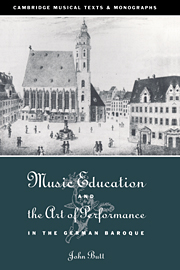Book contents
- Frontmatter
- Contents
- List of plates
- Preface
- Acknowledgements
- List of abbreviations
- 1 The establishment of Lutheran musical practice in the sixteenth century
- 2 The role of practical music in education c. 1600-1750
- 3 The contents, layout and style of instruction books
- 4 The development of performance practice and the tools of expression and interpretation in the German Baroque
- 5 Ornamentation and the relation between performer and composer
- 6 The decline of the Lutheran cantorates during the eighteenth century
- Notes
- Bibliography
- Index
5 - Ornamentation and the relation between performer and composer
Published online by Cambridge University Press: 03 December 2009
- Frontmatter
- Contents
- List of plates
- Preface
- Acknowledgements
- List of abbreviations
- 1 The establishment of Lutheran musical practice in the sixteenth century
- 2 The role of practical music in education c. 1600-1750
- 3 The contents, layout and style of instruction books
- 4 The development of performance practice and the tools of expression and interpretation in the German Baroque
- 5 Ornamentation and the relation between performer and composer
- 6 The decline of the Lutheran cantorates during the eighteenth century
- Notes
- Bibliography
- Index
Summary
Of all the elements of Baroque performance, ornamentation – particularly that which is not indicated by the notation – is the one which is most alien to those modern views which regard the musical text as an immutable record of the music. However, it should be one of the most important considerations in any history of the music of this period, since it concerns the cross-over area between performance and composition. Indeed it may well be that much music would not have been notated in the manner in which it survives without the influence of the performer and the trends in improvised ornamentation. This point was uncannily well summarised in an observation by Christoph Bernhard (mid seventeenth century), someone who significantly combined the arts of composer, compositional theorist and performer:
Since it has been observed that artistic singers and also instrumentalists … have somewhat digressed from the notes here and there, and thus have given occasion to invent an agreeable kind of figure; for what can be sung with reasonable euphony might well indeed also be written down.
Accordingly, composers in the last generation already began to set down one thing or another that was unknown to their predecessors, and seemed unacceptable to the unenlightened, but charming to good ears and musicians.
So that by our own time music has attained such a height, that – in view of the multitude of figures, particularly in the newly discovered and ever more decorated Stylus Recitativus – it may indeed be compared to a rhetoric.
- Type
- Chapter
- Information
- Music Education and the Art of Performance in the German Baroque , pp. 121 - 165Publisher: Cambridge University PressPrint publication year: 1994

